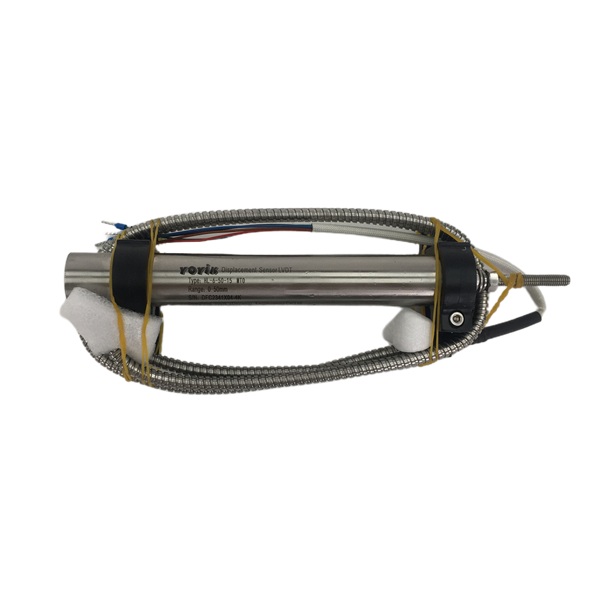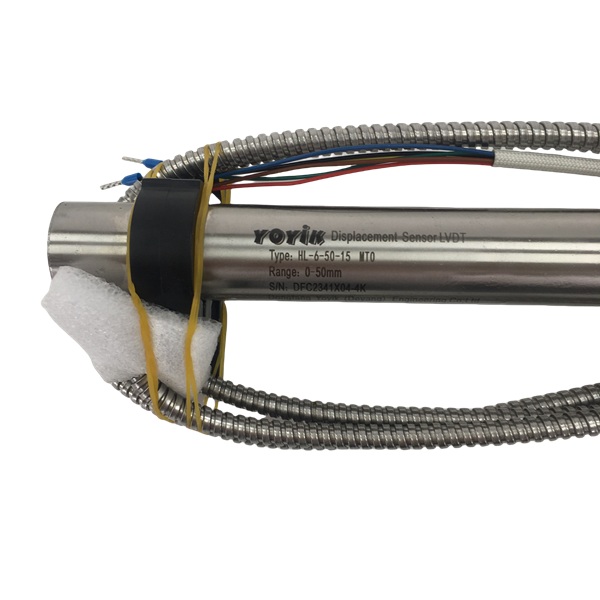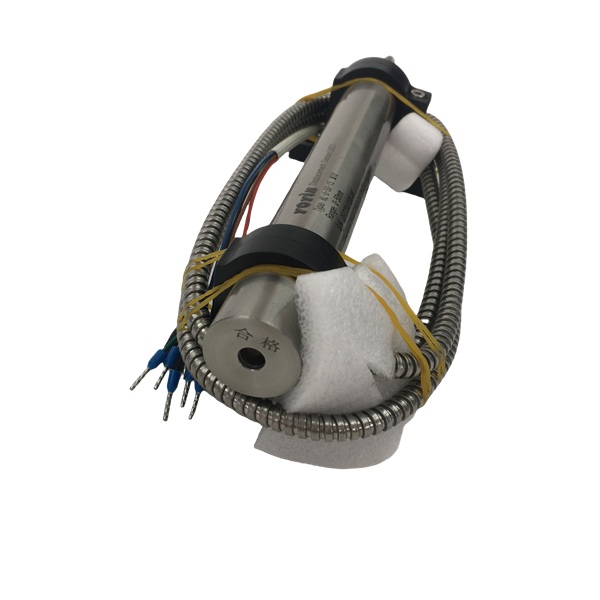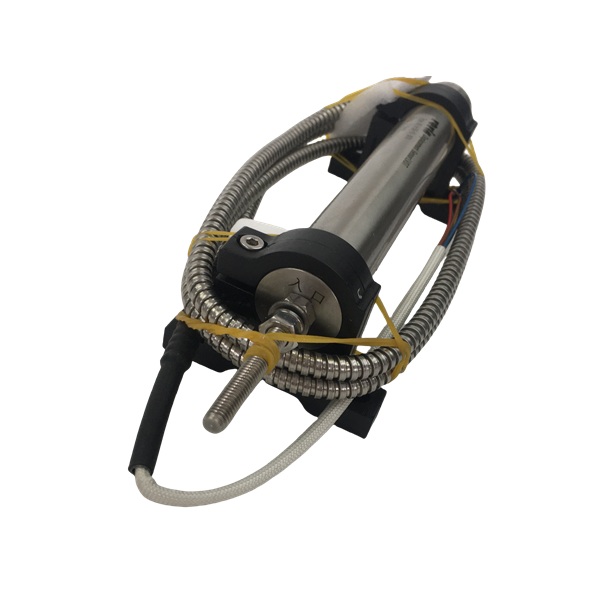
Working principle
LVDT position sensor HL-6-50-15 is mainly composed of a primary coil, two secondary coils and an axially movable iron core. When the AC excitation signal is passed into the primary coil, an alternating magnetic field is generated. Under the influence of this magnetic field, the two secondary coils will induce an electromotive force. Under normal conditions, the iron core is in the middle of the two secondary coils. At this time, the electromotive forces induced by the two secondary coils are equal in magnitude and opposite in direction, and the output voltage is zero. Once the actuator moves the iron core, the balance is broken, the electromotive force induced by the two secondary coils differs, and the output voltage is no longer zero. Moreover, the magnitude and polarity of the output voltage are directly related to the displacement of the iron core. By detecting this output voltage, the displacement information of the actuator can be accurately obtained. For example, when the actuator pushes the valve to open and drives the iron core to move, the output voltage of the sensor changes, and the displacement value can be converted after processing by the supporting circuit.
Performance characteristics
1. High-precision measurement: For the displacement measurement of the actuator of the steam turbine, accuracy is crucial. The accuracy of HL-6-50-15 can reach 0.1% FS or even higher, with excellent linearity and stability. Taking a 300MW steam turbine as an example, if the stroke range of its actuator is 0-100mm, the measurement error of the sensor can be controlled within 0.1mm, ensuring that the control system regulates the actuator according to the precise displacement data, ensuring the precise control of the steam inlet of the steam turbine, and maintaining the stability of the speed and load.
2. Strong reliability: Made of high-quality materials, such as stainless steel shell, it not only has good mechanical strength, can resist vibration and impact during turbine operation, but also effectively prevent external water vapor, dust and other corrosion of internal precision parts. The internal circuit has been specially designed and processed, and has excellent anti-interference ability. In a complex electromagnetic environment, it can also stably output accurate measurement signals to avoid measurement errors or signal fluctuations caused by interference.
3. Wide temperature adaptability range: When the turbine is running, the working environment temperature of the actuator changes greatly. The operating temperature range of HL-6-50-15 is usually - 50℃ - +150℃, and some special specifications can reach - 50℃ - +280℃. Whether it is the start-up stage of the unit in the cold winter or the high temperature full load operation in the summer, it can work normally to ensure the stability and accuracy of displacement measurement.
4. Rapid dynamic response: The actuator moves quickly, requiring the sensor to respond quickly. The dynamic frequency of the LVDT position sensor HL-6-50-15 can reach 0 - 200Hz (3db), which can track the displacement changes of the actuator in real time and output measurement signals in time. Under conditions such as sudden load changes and emergency load shedding of the steam turbine, ensure that the control system obtains displacement information in time, quickly adjusts the actuator action, and ensures safe and stable operation of the steam turbine.
Technical parameters
1. Range: The "50" in the model indicates that its range is 0-50mm, which can meet the displacement measurement needs of most steam turbine actuators. Of course, there are other range specifications available for different steam turbine designs.
2. Output signal: Common output signal types include voltage type, such as 0-5V, 0-10V, ±5V, etc.; current type, such as 4-20mA. Different output signals are easy to adapt to different interfaces and modules in the steam turbine control system to achieve stable data transmission and processing.
3. Excitation power supply: The excitation power supply frequency is generally a sine wave or square wave, ranging from 1-5KHz. The primary excitation voltage is commonly 3Vrms, and can also be adjusted between 1-5Vrms according to actual applications to ensure that the sensor works stably and outputs accurate signals.
4. Zero voltage: The zero voltage is less than 0.5% of the full-scale output, ensuring that the output signal error is extremely small when the core is in the initial equilibrium position, improving the measurement accuracy.
5. Sensitivity drift: The zero drift is less than 0.02%/℃, and the full-scale drift is less than 0.03%/℃, which means that when the temperature changes, the sensor sensitivity remains stable and the measurement accuracy is less affected by temperature.
Application
Application of LVDT position sensor HL-6-50-15 in turbine actuator:
1. Actuator stroke monitoring: Real-time monitoring of the actuator piston displacement, and continuous transmission of displacement data to the turbine control system. The operator can intuitively understand the working status of the actuator through the control system interface, judge whether it is acting according to the command, and whether the stroke is within the normal range, providing a key basis for the evaluation of the turbine operation status.
2. Valve opening control: Closely related to the turbine steam inlet valve, the valve opening is indirectly and accurately controlled by accurately measuring the displacement of the actuator. When the turbine load is adjusted, the control system adjusts the displacement of the actuator according to the set load and actual speed and other parameters, and the sensor feeds back the displacement information in real time to ensure accurate adjustment of the valve opening, control the steam intake, and achieve stable control of the turbine speed and load.
3. Fault diagnosis and early warning: During the continuous monitoring of the displacement of the actuator, if there is abnormal fluctuation in displacement or it exceeds the normal range, the sensor output signal will also be abnormal accordingly. After the control system captures the abnormal signal, it can trigger an alarm in time to remind the staff to check the actuator and related equipment, check whether there are problems such as component wear, jamming, and hydraulic system failure, prevent the expansion of faults in advance, and ensure the safe operation of the turbine.
- English
- French
- German
- Portuguese
- Spanish
- Russian
- Japanese
- Korean
- Arabic
- Irish
- Greek
- Turkish
- Italian
- Danish
- Romanian
- Indonesian
- Czech
- Afrikaans
- Swedish
- Polish
- Basque
- Catalan
- Esperanto
- Hindi
- Lao
- Albanian
- Amharic
- Armenian
- Azerbaijani
- Belarusian
- Bengali
- Bosnian
- Bulgarian
- Cebuano
- Chichewa
- Corsican
- Croatian
- Dutch
- Estonian
- Filipino
- Finnish
- Frisian
- Galician
- Georgian
- Gujarati
- Haitian
- Hausa
- Hawaiian
- Hebrew
- Hmong
- Hungarian
- Icelandic
- Igbo
- Javanese
- Kannada
- Kazakh
- Khmer
- Kurdish
- Kyrgyz
- Latin
- Latvian
- Lithuanian
- Luxembou..
- Macedonian
- Malagasy
- Malay
- Malayalam
- Maltese
- Maori
- Marathi
- Mongolian
- Burmese
- Nepali
- Norwegian
- Pashto
- Persian
- Punjabi
- Serbian
- Sesotho
- Sinhala
- Slovak
- Slovenian
- Somali
- Samoan
- Scots Gaelic
- Shona
- Sindhi
- Sundanese
- Swahili
- Tajik
- Tamil
- Telugu
- Thai
- Ukrainian
- Urdu
- Uzbek
- Vietnamese
- Welsh
- Xhosa
- Yiddish
- Yoruba
- Zulu
- Kinyarwanda
- Tatar
- Oriya
- Turkmen
- Uyghur














